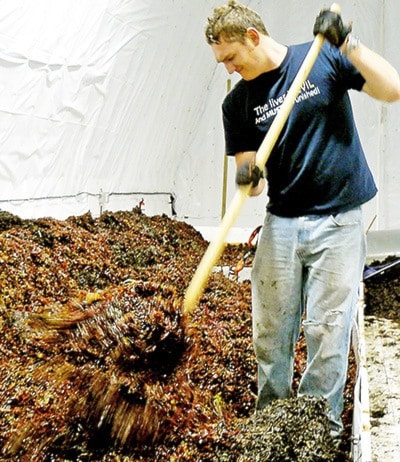Jonathan Biley knows there are some people who are concerned about his seaweed harvesting operation between Deep Bay and Qualicum Beach.
However, he says far from devastating the marine ecosystem of Baynes Sound, the harvesting of the invasive species Mazzaelia japonica could actually improve it, do a small bit to slow global warming and provide jobs in an industry that could one day rival both forestry and fishing as a job generator on Vancouver Island.
The key, he said, is to harvest the seaweed responsibly, something he said he takes great care to do.
“We are against harvesting from live beds,” he said. “We only harvest what has been detached by the storms and which would otherwise rot. That’s the key to sustainable harvesting.”
That sustainability is important, he said, as the seaweed is used to make carrageenan, a widely-used thickener that has a growing demand worldwide.
“We have an untapped resource that may be one of Vancouver Island’s biggest industries and I want it to be there for my grandchildren,” he said. “The world demand for this stuff is at a record high — largely because of people’s insatiable demand for, among other things, ice cream.”
Baynes Sound, he said, is a particularly rich in the seaweed, which was introduced to the area from Japan more than half a century ago.
“After a big storm you can see windrows of this stuff that stretch for kilometres,” he said. “It’s an invasive species that has completely overtaken Baynes Sound. When I’m scuba diving I see nothing but Mazzaelia japonica.”
Biley bases his operation on Beaver Meadow Farms, a 32-hectare organic farm run by Edgar Smith and his brothers.
Smith said his farm is an organic operation that puts a strong emphasis on being sustainable.
“We are a holistically-managed farm,” he said. “All our beef, dairy and cranberries are in sync with nature and we don’t use any chemical fertilizers or pesticides.”
Smith said he agreed to let Biley use one of his barns to dry the seaweed after he learned about the operation and felt it conformed to his ideas about sustainability.
“Our ideas are very similar,” he said. “We are taking an approach to protect the beach. We are trying to make it a sustainable use of resources, like we do with our farm.”
Faye Smith, the head of the Mid-Island Streamkeepers group, isn’t so sure about the operation, noting the dead seaweed — which she calls the compost of the ocean — provides a great deal of habitat for creatures at the bottom end of the food chain.
“We have just begun to appreciate what’s really happening on the shore,” she said. “The forage fish such as smelt and sandlance spawn at the top part of the beach, so we need to protect the beaches. If you have machinery running over eggs that are growing there, it could be a concern. The beach is so important to the life cycle of all the fish and seabirds.”
Biley is aware of those concerns and he said he makes every effort to make as small an environmental impact as possible.
“We want to do it right,” he said. “We will stop harvesting before the herring spawn or as soon as we notice any eggs. We have harvested dozens of tons so far and all we’ve noticed was a dead crab. We pitchfork the seaweed off the beach and, once we get our harvest vessel on stream, we will be able to keep tracked vehicles off the beach altogether.”
In the meantime, he said the ATV he uses cooking oil as fuel and has rubber tracks in order to spread the weight across the sand surface, meaning the vehicle has less impact on the surface than a person walking on it.
“I’ve been told — although I don’t want to test it — that you could run right over somebody with this thing and not injure them,” he said. “The fuel is completely biodegradable, so there’s no danger from a spill.”
Biley pledged to ensure his operation won’t cause the same sort of devastation to seaweed stock as has been experienced on Canada’s east coast — which was caused by harvesting live plants.
“We are one of the last wild sources left and it is imperative that we don’t make the same mistake others have made around the world,” he said. “As long as we stay out of the live beds, we should have a sustainable resource indefinitely.”
